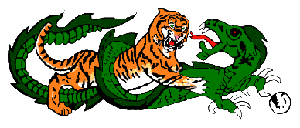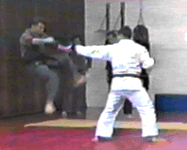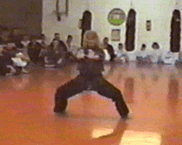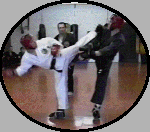|
|
Master Charles Conley originated the Lung-Fu-DoKarate System in Baltimore, MD during the late '60's. As this discipline began to gain a following in the area, he saw a need to develop a course of study for enthusiasts of this particular style. (An avid practitioner himself, he wanted to make the martial arts available to everyone.) He then authored a text to be used as a basic guidebook, both for his students and for others who did not have access to a dojo. Using this book as a source, Master Conley will answer your questions about Karate and Lung-Fu-Do (adapted from his book "Lung-Fu-Do Karate") |
|
|
|
|
|
|
|
|
|
|
|
 What does that mean? If you are a student of the martial arts, you may have noticed that the various styles seem to end with the word "do". (Tae-kwon-do, aiki-do, hapki-do, etc.) The word "do" means the way. In our case, Lung-fu-do means The Way Of The Dragon and Tiger.
What does that mean? If you are a student of the martial arts, you may have noticed that the various styles seem to end with the word "do". (Tae-kwon-do, aiki-do, hapki-do, etc.) The word "do" means the way. In our case, Lung-fu-do means The Way Of The Dragon and Tiger.
The dragon endeavoring to capture the pearl is a familiar one to karate practitioners. The dragon represents the master who has achieved the maximum knowledge possible in one life time. The pearl represents the knowledge he has yet to obtain. It is said that in order to learn all the knowledge of karate, one must live three times the normal life span. This being true, the dragon (master) can never capture the pearl (all knowledge). Another character sometimes appearing with the dragon and pearl is the tiger. The tiger represents the novice practitioner trying to take the high ground of the dragon and in turn, endeavor to capture the pearl. This is depicted in our logo which is seen above.
 One Steps require two people, the initiator of the technique (the one who throws the punch) and the practitioner (the one who performs the technique). A one-step employs a basic lunge and strike (by the initiator), and a block and premeditated technique (by the practitioner). It is called one-stepping because the initiator of the technique, after lunging and striking, remains immobile allowing ample time for the practitioner to practice and complete the technique. Our intermediate and advanced one-step techniques end with a take down and a follow-up hand or foot technique.
One Steps require two people, the initiator of the technique (the one who throws the punch) and the practitioner (the one who performs the technique). A one-step employs a basic lunge and strike (by the initiator), and a block and premeditated technique (by the practitioner). It is called one-stepping because the initiator of the technique, after lunging and striking, remains immobile allowing ample time for the practitioner to practice and complete the technique. Our intermediate and advanced one-step techniques end with a take down and a follow-up hand or foot technique.
In a classroom and a practice environment, it is imperative that the practitioner exhibit focus and control. Keep in mind also that these are only training techniques. You will have to modify them to fit the opponent's response. [In an actual fighting situation your opponent may double over when you kick him in the groin, instead of dropping to the ground like you have practiced. In this case, you will have to alter your strikes to fit his reaction.]
 Kata (Forms) are prearranged movements and combinations of techniques that are practiced as if shadow boxing. One-Step practice teaches accuracy, timing, response, control, and the feel of resistance. Forms teach balance, speed and power, muscle co-ordination, proper breathing and form, and provides the opportunity of practicing against multiple attacks.
Kata (Forms) are prearranged movements and combinations of techniques that are practiced as if shadow boxing. One-Step practice teaches accuracy, timing, response, control, and the feel of resistance. Forms teach balance, speed and power, muscle co-ordination, proper breathing and form, and provides the opportunity of practicing against multiple attacks.
Since Lung-Fu-Do is a Chinese-influenced hard/soft style, you will find techniques borrowed from many disciplines. We use the crane strikes, serpent head strikes, tiger paw base palm strikes, and dragon's mouth techniques - all from various kung-fu styles. You also find the traditional reverse punch, vertical fist strike, base palm strikes, blocks, and kicks from more traditional karate styles. Some of our kata would be considered hard style, while others would be a more flowing, soft style. Master Conley has adapted the best from many karate styles to form Lung-Fu-Do.
 At the Dan-San School we emphasize safety when sparring:
At the Dan-San School we emphasize safety when sparring:
To practice kumite techniques you will need a partner and some basic sparring techniques. Develop and practice these techniques until they become an automatic response. Then have your partner initiate an unknown attack. You should be able to fabricate and execute your counter attack "on the fly". Your counter attack should be executed as quickly as possible after blocking or avoiding the opponent. When you can promptly respond to the attack, you are ready for kumite.
As a beginner, you should employ only two strikes. The first as a fake or check, the second to score. (A fake is a strike meant to deceive an opponent. A check is for gaining information about his reactions, his balance, concentration, speed, etc.)
There are two general rules to keep in mind when developing techniques:
Sensei Santelli, the instructors and students at the Dan-San School of Karate thank you for dropping by.